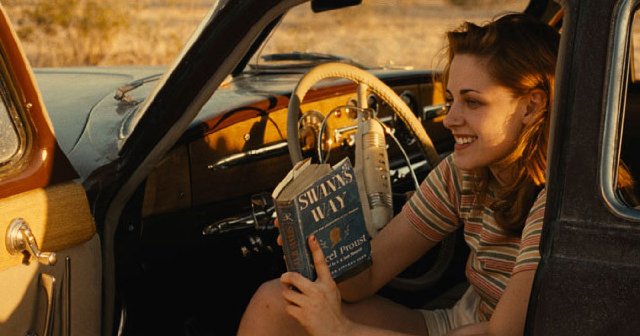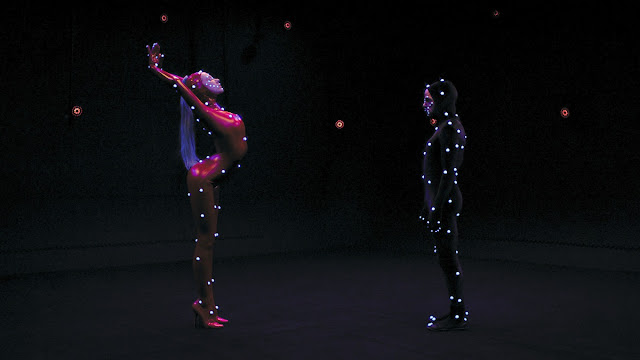With Martin Scorsese celebrating his 70th birthday today, what better time than to count down 10 of the greatest achievements of one of America's greatest directors? Unlike his contemporaries, Scorsese has enjoyed a typically stable level of quality over the course of his entire career, not flaming out like a Cimino or Coppola nor exploding beyond his initial, intimate scale the way Spielberg and Lucas did. A consummate craftsman, Scorsese continues to employ technical mastery on a level that up-and-comers can only imitate, and often through contradictorily old-fashioned means. Think the tangible recreations of
Gangs of New York, or the lush Technicolor throwbacks of
The Aviator or
Shutter Island. And when presented with new technology, as with digital and 3D, the director looks not merely to replicate the feel of film but to explore how these technical aspects can influence new directions in storytelling.
Not content merely to provide the world with his own string of great and memorable films, Scorsese has devoted much of his life to the preservation of the movies that inspired him, keeping them alive to motivate the next generation of movie brats. It can be difficult to whittle down his impressive filmography, filled not only with features but documentaries, concert films, shorts, even music videos and advertisements. These 10, however, distill the best of my all-time favorite director.
10. Mean StreetsBoth De Niro and Scorsese had made films before
Mean Streets (De Niro had even appeared in a masterpiece in the form of
Hi, Mom!), but that slo-mo scene of De Niro bouncing onto screen to the strains of "Jumpin' Jack Flash" feels like an announcement of arrival for both. Swathed in the Catholic guilt that would become one of Scorsese's trademark tics,
Mean Streets refines the raw, Cassevetes-inspired work that preceded this third feature and funnels it toward an exciting, developed voice. The director would continue to develop his skills over the years, but the immediacy of this breakthrough still offers one of the best insights into the director's canon of self-destructive characters pursuing hollow, often dangerous dreams and paying dearly for them.
9. Shutter IslandAs Roberto Rossellini once said of Chaplin's
A King in New York,
Shutter Island is the work of a free man. Having finally gotten his Oscar for an enjoyable but wan self-parody, Scorsese threw himself into some good pulp and produced this elegantly colorized, paranoiacally unsettled thriller. Sure, the twist can be seen from the boat pulling into the prison island's harbor, but it's the journey that counts, and Scorsese spins out a masterful yarn that plys his Im- and Ex-pressionist tendencies to their fullest use since
Bringing Out the Dead. And after
The Departed basically used a "Best Songs from Scorsese Films" playlist for its soundtrack,
Shutter Island sources canonical and contemporary classical music and ambient noise to further trap its plunging crimsons and multiple image sources (several kinds of film stock
and digital are used) in a time all its own. It even manages to revisit the irritatingly expository dénouement of Hitchcock's
Psycho with a more devastatingly personal twist.
8. Raging BullLeave out Robert De Niro's overhyped weight fluctuations and
Raging Bull still contains one of the all-time great performances for its complete understanding of character. Whether lean and mean or fat and broken, De Niro gives Jake La Motta the braggadocio, intensity and insecurity a boxer who came from nothing would feel, making it big and falling pray to all the impulses no longer restrained by income level. Scorsese more than matches his muse: the boxing scenes are a tour de force, aping the great ballet scene of
The Red Shoes by occurring in the subjective experience of the protagonist, who gets in the ring not for the crowd around him but to pummel the poor son of a bitch in front of him. The fights take place against a black void of white noise, which makes the matches as disturbing as the astonishing prosthetic and makeup work that shifts features with every sick punch.
7. GoodfellasSo many position
Goodfellas as the recipient of
The Godfather's baton, but in nearly every way it is the opposite of Coppola's operatic saga. The Corleone family comprise a host of Greek tragic figures, perversely successful immigrants and wholesome American heroes turned fratricidal monsters. The characters of Scorsese's gangster masterpiece, however, are nasty, brutish and stupid, in the game solely to satisfy their id and dying suddenly when they make one wrong step. To put it another way,
The Godfather sticks with the masterminds;
Goodfellas stays with those the masterminds plot to whack when they get out of line. For sheer bravura filmmaking, the coke-soaked sequence of the FBI closing in on Ray Liotta's burned-out hood has rarely been matched by anyone, even Scorsese himself.
6. Gangs of New YorkUnfortunately compromised with a tacked-on love story and a bit too unwieldy even without the influence of studio notes,
Gangs of New York nevertheless serves as Scorsese's messiest valentine to his hometown and the legacy of blood that built it. Released in the aftermath of the September 11 attacks,
Gangs demonstrates that xenophobia and carnage are inherent in New York's story, but so too is the desire to make a better life. The film suggests that some battles are worth fighting while others are merely worthless, and the opinion of the mob may not always see which is which. And though the film technically concerns Leonardo DiCaprio's avenging son of an immigrant, it hinges on Daniel Day-Lewis, an Irishman playing an anti-Irish gang leader whose extradiegetic contradictions manifest in the character. A brute whose preference of open conflict over democratic gentility anthropomorphize the Civil War that only intrudes upon the myopic street wars depicted here at the feature's end, Bill is equally capable of honor and dignity for those he carves so ruthlessly. One of Scorsese's messiest films, to be sure, but also one of his purest.
5. Life LessonsScorsese's segment in
New York Stories (the only worthy one of the trio) returns to the Dostoevsky well that served him so well with his Palme D'Or winner, this time loosely adapting
The Gambler rather than
Notes from Underground. "Life Lessons" uses a painter's block and his strained relationship with an assistant who wants to break away with him in order to craft a vision of art as expansive and intimate as the vast canvas Nolte's character throws paint upon in brief, tightly shot fits of creativity. Deafening music, blinding stylistic flourishes and more turn the protracted hell of Dobie's emotionally wrought creative process into a larger portrait of how art inspires, torments and releases. In 45 minutes, Scorsese says as much about why he lives to create as much as his lengthy documentaries on the films that inspire him.
4. The Last Temptation of ChristWhen I found it online shortly after watching the movie, the Siskel & Ebert review of
The Last Temptation of Christ struck me as much as the film itself. In it, Gene Siskel noted that Willem Dafoe’s Jesus “knows it is harder to be a good man than a god.” That single line captured the whole film for me, an atheist who always felt awful watching Jesus walk to his death with the supposed foreknowledge of what he would endure. Scorsese uses that prescience as perhaps the greatest agony Christ faced, filling Him with Catholic guilt before the Church could even grow out of His sacrifice. By showing Jesus as a man (emphasis on
man, not Son of God), Scorsese actually lends greater credence to the power of His words because Jesus wrestles with every teaching, every temptation. Sympathy, too, is spared for Judas, who knows the role he must play and is torn up by the awful responsibility placed upon him. The titular final temptation, in which Christ gets to live out a peaceful, happy life as he bleeds out on the cross, is Scorsese's greatest moment to date.
3. Bringing Out the DeadEvery so often, Scorsese cleanses his palate with a pure exercise in style.
After Hours,
Casino,
Shutter Island and the like let off creative steam when the director gets too overheated.
Bringing Out the Dead, however, mixes this glorious excess with a genuinely great script, messing with
Taxi Driver’s components until that movie somehow morphs into a touching romance between two broken individuals and between a shattered Christ figure and his even-worse-off flock. Nicolas Cage gives one of his best performances, wild but wounded, capable of playing to the sensory overload of the frame but centered enough to ground it. So many of Scorsese’s films are hallucinations. None is more pained than this.
2. Taxi DriverSo ensconced in the pop culture lexicon that it almost suffers for being put on a pedestal,
Taxi Driver remains a singular achievement, as intimate as it is vast and so wrapped up in its protagonist that the man is, to this die, cited as both an anti-hero and a total villain. Scorsese's hell-vision of New York is repugnantly realized, Bickle's hatred transferred through the subjective lens onto the entire city. It no longer even resembles a metropolis but a state of mind, hissing steam, dripping grime and grinding innocence into pulp between molars. The only thing worse than staring at this world through Travis' eyes is the moment when Scorsese, unable to bear it any longer, briefly tracks away from the psychopath and the vacant hallway upon which he settles disturbs more than the sight of Travis' worst carnage.
1. The King of ComedyThe King of Comedy feels so unlike a Scorsese film, endothermic where his work usually burns will spare energy and static instead of vivid. Rupert Pupkin even erects a dream world around himself of unmoving cardboard cutouts, celebrities and a two-dimensional wall of an adoring crowd frozen in love for whomever stands in front of them. Bickle simmered until he exploded, but even Pupkin’s most drastic actions reveal an insularity as the anxious, fame-hungry loser collapses into his paper-thin fantasy. Among the film’s many ingenious, brutal reflections on celebrity, the best may be the anticlimax and denouement, almost entirely shown through the filter of a TV screen, reflecting how Pupkin’s triumph would be transmitted but also weakening the impact with soft video images. For Scorsese, the master aesthete, the inferior image quality clearly connotes the negative aspect of fame for fame’s sake, but as celebrities famous simply for being famous have exploded in recent years,
The King of Comedy looks enduringly fresh in its analog conclusion.













































